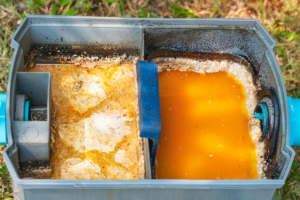One of our teams was called out recently because fat and food waste from a restaurant was literally flooding a town car park. This was because the restaurant had not installed their grease trap correctly.
Managing grease traps is a horrible job but it’s essential if you want your restaurant to continue running smoothly – and legally.
A FOG problem 
No matter what sort of restaurant you run, your kitchen generates FOGs (fats, oils, grease and starches). And if they aren’t managed properly, FOGs put a large strain on the local sewage system, causing blockages, floods and bad odours, as well as creating the ideal environment for vermin and disease.
For you, this could mean expensive repairs and clean-ups, bad publicity, lost custom or even a fine or closure.
The problem is that when they are hot, FOGs are liquid, so we can just tip them down the plug hole. But when they cool down, they solidify. If caught by existing fat blockages, they add to the growing obstruction until you’ve got a fatberg on your hands!
Fatberg ahoy
It’s estimated that nearly half a million tonnes of FOGs get poured into Britain’s sewage system every year. The largest fatberg recorded in the UK was found in a sewer under a street in Liverpool in 2019. It was 250m long and weighed 400 tonnes.
However, if your FOGs are collected in a grease trap and you keep your drains and trap regularly cleaned, you can avoid this titanic problem.
What is a grease trap?
A grease trap is a tried and trusted method of separating FOGs from waste-water flow. It’s simply a tank made up of several separation chambers that sits between your kitchen sink and the public sewer, intercepting and slowing down the flow of waste.
This allows FOGs to cool, solidify and separate out by floating to the surface. Food debris will settle to the bottom of the trap while the wastewater continues flowing into the sewer.
Grease traps are usually sufficient for small-scale kitchens, but if yours produces a lot of FOGs, you might need a grease separator. These are often installed underground outside large restaurants or hotels and handle much larger volumes of waste, but they work in a similar way.
Managing grease traps
For a grease trap to work efficiently and to prevent smells or blockages, it needs regular emptying and cleaning – at least every few months.
You can tell when your grease trap needs cleaning if you can smell bad odours in your premises, if water takes more time to drain, and if the water level in your trap is unusually high. You may also get more greasy sinks and surfaces as the FOGs have nowhere to go.
Here are our tips for keeping on top of your FOGs.
Set up a regular cleaning schedule. It’s not a nice job but it prevents a worse one down the line. This means draining the trap and getting into the interior with a high-pressure water hose to remove stubborn lumps whenever you see the signs, and at least every 2-3 months.
Educate your staff. A proper disposal protocol and training for FOG disposal will prevent problems in the first place. Your staff should also know how to use personal protective equipment and cleaning gear.
Keep professional help on speed dial. A company like ours has the equipment and training to deal with flood water and FOGs, as well as clearing blockages in drains and sewers. This reduces disruption to your operation and inconvenience to customers.
D&S drain relining services
Just as fats can clog up your arteries, they can do the same with drains and sewers, increasing the risk of infestation by vermin and insects, and bacterial contamination.
If you are looking for a professional partner with the experience, know-how and training to deal with a kitchen sink drama and give advice on installing and maintaining commercial drainage systems, then Drain and Sewer Services of Aldershot offers a full range of services.
If you would like to talk to us about our drain and sewer services, then call us on 01252 312738 or email info@drainandsewer.co.uk. for more information or a quote.

